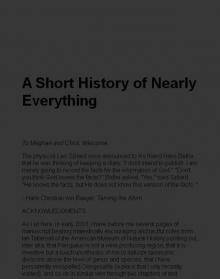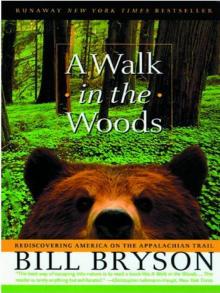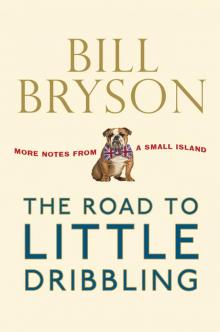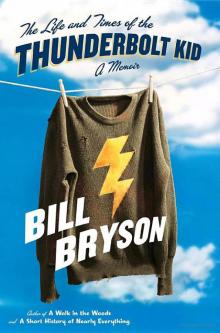- Home
- Bill Bryson
The Road to Little Dribbling Page 33
The Road to Little Dribbling Read online
Page 33
In 1994, I did an article for the National Geographic magazine on the Lake District. Then, the Lake District received 12 million visitors a year. Now it is 16 million. Ambleside, one of the main towns, received up to 11,000 cars per day. Today the number can exceed 19,000. All these people are packed into an area of exceedingly modest dimensions. The Lake District National Park is only thirty-nine miles long from top to bottom, and thirty-three miles across at its widest point. Put another way, the Lake District gets four times as many visitors as Yellowstone National Park in America in an area just a quarter the size. On the busiest days, a quarter of a million people pour in.
And yet it handles it remarkably well, on the whole. Most of the crowds go to just a few places – Ambleside, Grasmere and Bowness primarily. If you walk just a couple of hundred yards up any footpath you can easily get a whole hillside to yourself. That’s what I did now. Just beyond Buttermere, I came to a rough earthen car park with only two cars in it (in one of which, honestly, a couple were having a nap) and decided to park and go for a little walk. The landscape looked oddly familiar, then I realized from my map that I was on the lower slopes of Haystacks, a hill I had walked over with Jon Davidson and his friends in 2010. It looked positively enormous from below. The hills of the Lake District are not terribly high – the very highest, Scafell Pike, only a mile or so from where I stood now, is just over 3,200 feet – but they are muscular and steep. If you climb a Lake District hill, you know it.
An old riddle is how many lakes are there in the Lake District? The answer is one because only Bassenthwaite Lake has ‘lake’ in the title. All the other bodies of water use the terms mere (as in Windermere and Buttermere), water (as in Crummock Water and Coniston Water), and tarn (as in you get the idea). There are hundreds and hundreds of tarns, some not much bigger than puddles. So the answer is that there are sixteen lakes and hundreds of what any sensible person would call ponds. It is impossible to say which is the loveliest, but I do vividly recall once looking down on Derwent Water from the side of Skiddaw and thinking that heaven really must look like this. I had never been to the lake itself. I decided to correct that deficiency now.
Keswick is the main community on Derwent Water and I think is the most pleasant town in the Lakes. The main street had been pedestrianized since I was last there, and was much improved for it. I was pleased to see that Bryson’s Tea Room (est. 1947) is still going strong. I walked down to and then partway around the lake. It really is quite sensationally lovely, with clear, sparkling water spread beneath a backdrop of craggy mountains of stone and sheep-nibbled grass. A couple of hundred yards offshore is a wooded island, called Derwent Island, with a grand house on it. An information board from the National Trust informed me that an eccentric eighteenth-century owner named Joseph Pocklington held a regatta every year ‘where he challenged the people of Keswick to attack the island while he shot at them with his cannons’. They certainly know how to have a good time in the Lake District, it seems. I would love to have seen the island, even without cannon fire, but it is not generally open to the public, so I contented myself with an hour’s ramble at the lake’s edge.
Part of the reason I like Keswick is that it is full of outdoor shops. This is a place for people who just can’t get enough Gore-Tex into their lives. I went into an emporium called George Fisher’s and was so enchanted with its range of packs and water bottles and rustly waterproofs that I felt moved to buy something. I picked up a smart metal clip that you could use to hold together two objects – a water bottle to a rucksack, say – and never mind that I didn’t have two objects to hold together. One day I may, and when that day comes I will be ready. The man at the till gave me a nod of respect, recognizing me as a member of the fraternity, albeit one from the more waddly end of the spectrum.
‘Doing some walking?’ he said.
‘Headed for Cape Wrath,’ I responded solemnly.
‘Long way,’ he said, impressed.
‘Yes,’ I agreed, still solemnly, hoping he would recognize me and that for the rest of the day he would be saying to people, ‘Bill Bryson was in today. He was stocking up for an expedition to Cape Wrath,’ and that they would reply, ‘Goodness. He’s brave. I think I’ll go and buy some of his books.’ But he didn’t recognize me, so that fantasy was stillborn. On display by the till was a book called Peter Livesey: Stories of a Rock-Climbing Legend. I knew Pete Livesey. He lived a mile or so from us in Malhamdale, in North Yorkshire, when we were there in the 1980s and ’90s. I knew that he was a dedicated rock climber, but I had no idea that he was a legend – but then he was an admirably modest fellow. I bought the book and took it with me upstairs to a small café at the back of the shop, where I sat with a sandwich and read, impressed with Livesey’s skill and courage. I hadn’t realized, but he died of pancreatic cancer the year after we left Malhamdale. He was just fifty-four, poor man.
The café had one other group of customers, a party of four made up of two couples of early retirement age who seemed to be on holiday together. They were well dressed. Their accents were southern and educated. They each had coffee and cake, so their bill must have come to something like £20. When I got up to pay, a woman from their group was at the till already. She received her change and dropped a tip into a bowl by the till labelled ‘Tips’. The bowl was a little high for her to see into and I am guessing she assumed that it was full of coins already and that hers would disappear among many others, but when I stepped up I could see that the bowl had a solitary 10p coin in it.
Am I wrong or is this becoming a feature of British life – and I mean by that behaving in quietly disgraceful ways when you think no one is watching? I am not saying that this is exclusive to the British or that it is universal among them by any means. I am just saying that it barely used to exist at all and now you see it pretty regularly. The Britain I came to was predicated on the idea of doing the right thing most of the time whether anyone knew you were doing it or not. So you didn’t drop litter or empty your paint can at the kerb or let your dog shit on footpaths or wilfully take two parking spaces and all that sort of thing. You might not leave a tip – you were British, after all – but you wouldn’t pretend to leave a decent tip and then stick in a small coin. Slyness wasn’t part of the culture. It didn’t occur to you to be a dick. Now lots of people are governed not so much by whether something is right or wrong as by whether they think anyone’s watching. Conscience only operates when there are witnesses. Where did that come from? And what do you do about it when it infects even pleasant-looking ladies in Berghaus jackets?
I drove on to Bowness-on-Windermere, the Lake District’s principal town and tourist centre. Bowness is always described as bustling, which really means packed. It is perennially thronged with visitors, mostly white-haired, shuffling around, looking in windows, killing time between pots of tea, waiting for it to be time to go home. Since I came to the Lake District twenty years ago for my National Geographic article, the number of visitors has increased by 11,000 a day on average, and most of them seem to end up in Bowness without any clear idea of why they are there.
Bowness does have a lovely lakefront, it must be said. Windermere is the largest of the Lake District lakes, though that isn’t saying a great deal. It’s only ten miles long, barely half a mile wide at its widest extent, and often only a few feet deep. It is one of the most intensively studied lakes in the world thanks in large part to the Freshwater Biological Association, which has its headquarters at Windermere and has been dipping nets and beakers into its waters since 1929, one of the longest stretches of freshwater monitoring anywhere.
The British, as you may have gathered by now, are the most devoted studiers of nature on the planet. If a thing breathes or twitches or even just sits like lichen doing nothing at all, they are all over it. There is a British Bryological Society, a British Myriapod and Isopod Group, a British Phycological Society, a Simuliidae Study Group, a Malacological Society of London, a Conchological Society, a Chironomid Study Group, and of
course a British Lichen Society, plus several dozen more, all devoted to collecting, conserving and studying tiny living things that most of us are barely aware of, if at all.
And when I say study, believe me I mean study. Between 1976 and 2012, volunteers with the United Kingdom Butterfly Monitoring Scheme walked 536,000 kilometres of ‘butterfly transacts’ – which is to say, arbitrary squares of countryside – to record the state of the nation’s butterflies. Other groups have just as devotedly counted moths, bats, frogs, caddis flies, dragonflies, fungus gnats, freshwater flatworms and – well, everything. There is even a Slime Mould Recording Scheme, whose manager – I am so pleased to tell you this – lives in Mold. Some of what these people have found is more interesting than you might expect. A species of millipede was found in a domestic garden in Norfolk that has never been seen anywhere else on Earth. A moss that had only ever been recorded on the campus of Stanford University in California was also found living beside a footpath in Cornwall. How it came to inhabit two such dispersed localities and no others is a question no one can answer, though you can be certain it is the kind of thing they talk about pretty avidly during cocktail hour at moss conferences.
For the National Geographic article, I spent a morning on the lake with a young scientist from the Freshwater Biological Association without for a moment understanding a single thing she told me. I found the file with my notes in them the other day and this is the sort of thing they say: ‘Biotic assessment – dichotomous? Rotifers, ostracods, fairy shrimps. V. difficult to measure. Outlook not good. Diptera pupae. V. alarming!’
Eventually I stopped taking notes, and then stopped listening altogether and just enjoyed the scenery while she prattled away and dipped containers in the water. The man driving our boat was a park ranger named Steve Tatlock, and he told me that on a busy day you could have as many as 1,600 powerboats on Windermere, an amazing number for a lake of its size, all of them speeding wildly, many pulling waterskiers and slicing through flotillas of sailboats, rowboats, canoes, inflatable rafts and even some hardy swimmers, filling the lake with noise and danger and irksome, bouncy waves. England doesn’t have a lot of lakes, and most are closed to motorboats, so Windermere was a rare place where people could drop a boat in the water and let her rip.
Tatlock asked me if I wanted to experience the speed waterskiers went, and of course I did. He let the scientist stow her stuff, then threw open the throttle and we took off with a velocity normally only seen in cartoons. We bounced across the water, barely touching the surface. It seemed wildly reckless, but at least it was a quiet morning and we had a few acres of empty water to ourselves. ‘Imagine 1,600 other boats doing this,’ Tatlock shouted, ‘moving about in all directions at top speed. It’s absolutely mad.’
In 2005, after thirty years of arguing, a 10-mph speed limit was introduced on Windermere, so the lake is much improved for those who value tranquillity. As for all the things that live in and around it, the news isn’t so cheery. Algal blooms have become common and fish populations have been falling steadily for years. In the wider world of nature, things aren’t so good either. In 2013, a consortium of wildlife organizations released a report called State of Nature which found that about two thirds of all species in Britain, plant and animal, are in decline, in some cases perilously so. The number of breeding birds has fallen by 44 million since the late 1960s. Over a longer period, fourteen mosses and liverworts have vanished from the British landscape, as have twenty-three species of bees and wasps. Britain, it turns out, is outstanding at counting what it has, but not so good at holding on to it.
Still, I must say, on the day I was there it all looked lovely and healthy, too. The water by the shoreline was clear and the insects that darted about near its surface seemed happy enough, insofar as I am capable of judging, which obviously isn’t very far. I walked along the waterside to the landing stage for the ferry to Sawrey, and peered over the edge there, too. An empty cigarette packet sat in the water. I fished it out and gave it a shake and looked around for a bin, but there wasn’t one, so I sighed, squeezed it more or less dry, and put it in my jacket pocket. Realizing that there wasn’t much of anything else I could do about the state of nature at Windermere, or indeed most of the other matters troubling the planet, I wandered back to the car and moved on.
Chapter 24
Yorkshire
I STAYED THE NIGHT in Kirkby Lonsdale, unofficial capital of the Lune Valley. It is a region of great beauty that hardly anyone knows about, but then that can be said about a lot of this area. The Lake District and Yorkshire Dales National Parks so dominate everyone’s thinking that the rest of northwest England is blissfully overlooked. Go to the Forest of Bowland or Eden Valley and you can have it pretty much to yourself. The Lune Valley is as fine as anything in the Lakes (though without a lake, it must be said) or the neighbouring Dales, and yet who has ever heard of the Lune Valley?
Kirkby Lonsdale is a nice little town, compact and prosperous. It used to have shops selling jumpers made of local wool and little craft galleries and things like that, and those are mostly gone now, but there are more restaurants and cafés, which I suppose is what the world wants these days.
In the morning I drove to Sedbergh, an attractive town now in Cumbria but historically in Yorkshire, in the area known as the West Riding. Sedbergh is best known as the home of an ancient public school, also called Sedbergh, dating from the fifteenth century, but it has been trying in recent years to become known also as ‘England’s Book Town’, based on the fact that it has one large and excellent bookshop, selling mostly second-hand books, and a couple of smaller ones. It has a good hiking shop, excellent hardware store, some cafés and delis – in short, more than you would expect to find in a small and fairly remote place. There was just one really ugly building in town – a BT building. I wonder, has there ever been a company that has brought more ugliness and general dissatisfaction into the world than BT? Somebody needs to explain to me how it is that they cannot get a broadband signal from one side of a room to another in Hampshire, but if you call to complain about it they can instantly put you in touch with a testy fellow in Bangalore. But that is of course another matter.
I went into a café on the high street for a coffee. The café had clearly taken the Book Town boast to heart because it had a selection of books that customers could read while enjoying their refreshments. One that instantly caught my eye was a hardback called You Only Live Once by Britain’s number one goddess, Katie Price. You may only live once, as Ms Price so astutely observes (very little escapes her with regard to existential issues, I find), but clearly that needn’t stop you from writing about it again and again. This, I was surprised to learn, was her fifth autobiography – quite an achievement considering that she is only about twenty-five years old, I think (though some parts of her may be somewhat older). As well as her compelling autobiographical offerings, Ms Price has also written five novels. All this is in addition to running an international business empire and progressing through life with breasts that must weigh at least thirty kilos apiece.
You Only Live Once concerned only a fragment of Ms Price’s rich and eventful life, but appeared to involve two marriages, some children, and a number of relationships. Chapter One, entitled ‘Too Much in Love’, rather seemed to say it all. Chapter Six more intriguingly was entitled ‘Pink Up My Pony’. (I have no idea. I had only just had breakfast.) The book was primarily about her marriage to Alex Reid. They had met, I believe, in some Antipodean jungle while taking part in a Channel 5 television programme called I’ll Eat Bugs for Money. (I’m guessing this from the pictures.) They were married in February 2010 and divorced eleven months later. I’ve had pimples last longer than that.
I looked to see who published this treasury of high-class reminiscence and it was Random House, my very own publisher. I was part of the Katie Price family. We were corporately conjoined. But have they ever invited me to a launch party? Have they fuck.
And so to Yorkshire. I love Yorks
hire and Yorkshire people. I admire them for their bluntness. As I said in Notes from a Small Island, if you want to know your shortcomings you won’t find more helpful people anywhere. I lived for eight years in Malhamdale, not far from where I was now, and hardly a day passed when some crusty Dalesman didn’t take time to help me identify one or more of my deficiencies.
I love and miss Malhamdale, but decided now, for the sake of novelty, to visit some parts of the Dales I was less familiar with and so headed to Dentdale. Insofar as Dentdale is known at all, it is as one of the principal locations of the celebrated Settle-to-Carlisle railway line, which may be both the most picturesque and the most wonderfully unnecessary railway line ever built in England. It was conceived some time in the 1860s by James Allport, general manager of the Midland Railway, who wanted a route to Scotland. East coast and west coast routes already existed, so Allport decided to go up the middle. The only possible way was through the bleakest, remotest, emptiest stretch of the Pennine Hills, through seventy-two miles of landscape so irregular and deeply folded as to be an engineer’s nightmare. The project required fourteen tunnels, including one at Blea Moor that is almost a mile and a half long, and twenty-one viaducts, several of them quite enormous. None of this could ever be economic. Indeed, when it eventually dawned on Allport and his colleagues what a mad project it was, they applied to Parliament for an abandonment bill – which is to say, permission to pull out of the project – but Parliament sadistically refused to grant it.

 Notes from a Small Island
Notes from a Small Island A Short History of Nearly Everything
A Short History of Nearly Everything A Walk in the Woods
A Walk in the Woods I'm a Stranger Here Myself
I'm a Stranger Here Myself The Mother Tongue
The Mother Tongue Shakespeare
Shakespeare A Short History of Nearly Everything: Special Illustrated Edition
A Short History of Nearly Everything: Special Illustrated Edition The Best American Travel Writing 2016
The Best American Travel Writing 2016 The Road to Little Dribbling
The Road to Little Dribbling The Life And Times Of The Thunderbolt Kid: A Memoir (v5.0)
The Life And Times Of The Thunderbolt Kid: A Memoir (v5.0) Made In America
Made In America Seeing Further
Seeing Further Shakespeare: The World as Stage
Shakespeare: The World as Stage The Life and Times of the Thunderbolt Kid
The Life and Times of the Thunderbolt Kid At Home
At Home Bryson's Dictionary For Writers And Editors (v5.0)
Bryson's Dictionary For Writers And Editors (v5.0) Neither Here Nor There
Neither Here Nor There Bill Bryson's African Diary
Bill Bryson's African Diary